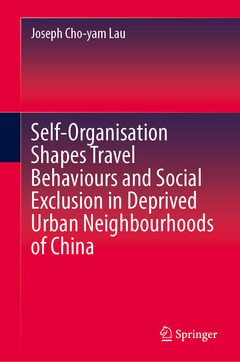Description
Self-Organisation Shapes Travel Behaviours and Social Exclusion in Deprived Urban Neighbourhoods of China, 1st ed. 2020
Author: Lau Joseph Cho-yam
Language: English
Keywords
Self-organisation process; Structuration theory; Individual accessibility; Top-down and bottom-up emergence; Independent decision and action; Space-time prism; Potential path area; Spontaneous travel behaviour; Equality of accessibility; Urban transportation planning; landscape/regional and urban planning
Approximative price 52.74 €
In Print (Delivery period: 15 days).
Add to cartPublication date: 03-2020
Support: Print on demand
Approximative price 52.74 €
In Print (Delivery period: 15 days).
Add to cartPublication date: 03-2021
224 p. · 15.5x23.5 cm · Paperback
Description
/li>Contents
/li>Biography
/li>Comment
/li>
Provides evidence that individual decision-action and social structure, in addition to the transport systems and the built-environment, are also vital factors influencing individual accessibility
Confirms that a significant proportion of poor workers’ travel problems are rooted in interaction between behaviour and social structures, and argues that any change in human actions or structures in the social systems results in the production of complex and spontaneous travel behaviour
Introduces the self-organisation approach for urban transport planning in the future
These books may interest you

Quality of Life and Daily Travel 52.74 €

Quality of Life and Daily Travel 52.74 €


